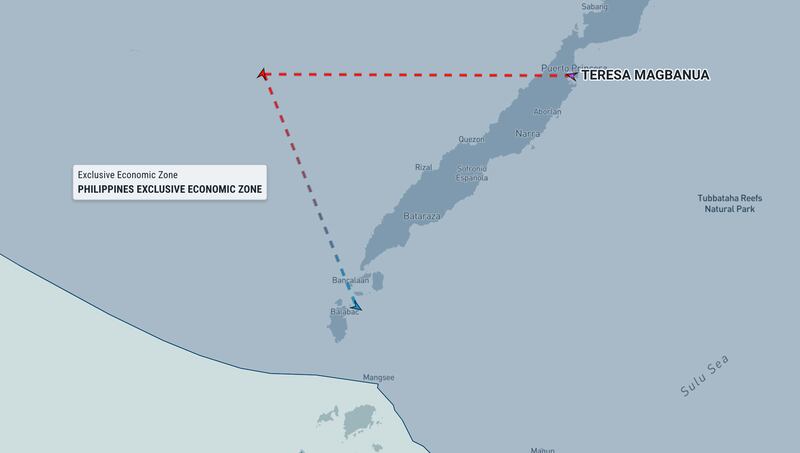UPDATED AT 5:30 ET on Sept. 15, 2024
The Philippines has withdrawn a coast guard vessel at the center of a standoff with China at a disputed shoal in the South China Sea, saying it had played a crucial role in “countering illegal activities” but had to return to port because of bad weather, low supplies and the need to get medical care for some of those on board.
The Sabina Shoal, about 140 km (85 miles) west of Palawan island, is claimed by both countries but is entirely within the Philippine exclusive economic zone, or EEZ, where the Philippines holds rights to explore for natural resources.
The five-month standoff with China at the shoal resulted in several collisions between Philippine and Chinese vessels, especially during Philippine resupply missions to its ship, the BRP Teresa Magbanua, raising fears of a more serious conflict between the Philippines, a close U.S. ally, and an increasingly assertive China.
“Their steadfast presence has played a crucial role in countering illegal activities that threaten our marine environment and thwarting attempts by other state actors to engage in surreptitious reclamation in the area,” the Philippine coast guard said in a statement, referring to the officers and men on board the ship.
Ship tracking specialists earlier told Radio Free Asia the 2,200-ton coast guard flagship left the hotly disputed shoal, known in the Philippines as Escoda, at around 1 p.m. on Friday.
Data provided by the website MarineTraffic, which uses automatic identification system, or AIS, signals to track ships, show that the BRP Teresa Magbanua (MRRV-9701) was back in the Sulu Sea near the Philippines’ Balabac island, about 200 km (125 miles) to the south of the shoal.

There was no immediate comment from China on the ship’s withdrawal from the shoal.
The BRP Teresa Magbanua is one of the largest and most modern vessels of the Philippine coast guard. It was deployed to Sabina Shoal in April to monitor what the Philippines fears is a Chinese plan to reclaim land there, as China has done elsewhere in the South China Sea.
Philippine officials insisted that the vessel could remain there for as long as necessary but China denounced what it saw as the “illegal grounding” of the BRP Teresa Magbanua and deployed a large number of ships there to keep watch. The Philippines denied that the vessel had been grounded.
Beijing feared that by maintaining the vessel’s semi-permanent presence at the shoal, Manila aimed to establish de-facto control over it, similar to what it has done at the Second Thomas Shoal, where an old Philippine warship, BRP Sierra Madre, was deliberately run aground to serve as an outpost.
For its part, the Philippines is worried that without the presence of its authorities, Chinese ships will swarm the area and effectively take control of it, as happened at Scarborough Shoal – another disputed South China Sea feature – where China has had control since 2012.
Sabina Shoal is close to an area believed to be rich in oil and gas, and also served as the main staging ground for resupply missions to the Sierra Madre at the Second Thomas Shoal.
Lower the tension
The Philippine coast guard said in its statement on Sunday that it was “firmly committed and determined in protecting the Philippines’ sovereignty, sovereign rights, and jurisdiction in the West Philippine Sea, including in Escoda Shoal.”
But Ray Powell, director of the U.S.-based SeaLight project at Stanford University, said China was likely to deploy to the area as it did at the Scarborough Shoal.
“The parallels are unavoidable,” said Powell, who monitors developments in the South China Sea.
“China is also likely to declare victory – hard to avoid that conclusion,” added the maritime security analyst.
The withdrawal comes days after Philippine Foreign Affairs Undersecretary Maria Theresa P. Lazaro met China’s Vice Foreign Minister Chen Xiaodong to discuss the situation at the shoal.
The Chinese side reportedly urged the Philippines to immediately withdraw its vessels while "Lazaro reaffirmed the consistent position of the Philippines and explored ways to lower the tension in the area," the Philippines Department of Foreign Affairs said in a statement after the Sept. 12 talks.
The Philippine coast guard made no mention of the talks in its statement.
Philippine analyst Chester Cabalza, president of the International Development and Security Cooperation think tank, described the withdrawal of the ship as “anti-climactic,” adding that he thought both sides should withdraw from the vicinity of the shoal, which is in an important sea lane.
Cabalza said if the Philippines and China had reached any agreement in their Sept. 12 consultation, that would become evident in the absence of any “swarming of Chinese armada” at the shoal.
“The ball is with China now,” the analyst told RFA’s affiliate BenarNews.
RELATED STORIES
China, Philippines trade blame over 'ramming' at disputed shoal
China releases report to fortify claim over disputed shoal in South China Sea
Philippines, China clash near disputed shoal in South China Sea
*Jason Guterriez in Manila contributed to this report.”
Editing by RFA Staff
This story has been updated to include comment from the Philippine coast guard.
